![]()
![]()
![]()
Use LEFT and RIGHT arrow keys to navigate between flashcards;
Use UP and DOWN arrow keys to flip the card;
H to show hint;
A reads text to speech;
64 Cards in this Set
- Front
- Back
|
Composition |
Placement or arrangement of visual elements or ingredients in a work of art |
|
|
Naturalism |
Aims at realism and accuracy of portrayal of subjects in their environment. |
|
|
Realism |
Attempt to resemble life as closely as possible. |
|
|
Monumental |
Combines two concepts, one of function, and one of size. A work of art that is large, specifically sculpture or architecture. |
|
|
stylized |
To design in or cause to conform to a particular style, as of representation or treatment in art; conventionalize. |
|
|
Abstraction |
Non-realist or naturalistic, but more symbolic and descriptive in color or shapes instead of recognizable images. |
|
|
Iconography |
Use of symbolism and icons that are recognizable of a culture, religion, figure, or idea. |
|
|
Attribute |
something used as a symbol of a particular person, office, or status: |
|
|
Personification |
human qualities are given to animals, objects or ideas. |
|
|
Votive Statue |
An image created as a devotional offering to a deity. |
|
|
Sarcophagus |
1. a stone coffin, typically adorned with a sculpture or inscription and associated with the ancient civilizations of Egypt, Rome, and Greece.
|
|
|
Repoussé |
A technique of hammering or pushing metal from the back to create a protruding image. Elaborate reliefs are created by pressing or hammering metal sheets against carved wooden frames. |
|
|
Lost-wax or Hollow-casting |
A method of casting metal, such as bronze. A wax mold is covered with clay or plaster, and the wax melts, leaving a hollow center. Molten metal is then poured into this hollow center, creating a smooth and polished metal after the plaster is removed. |
|
|
Free-standing |
Can be seen in the round, as is surrounded by space, instead of being a part of a building, like a frieze. May have a support. |
|
|
High Relief |
A 3 dimensional image whose background has been cut away to a high depth. |
|
|
Low Relief |
A 3 dimensional image whose background has barely been cut away |
|
|
Tempera |
A painting medium made by blending egg yolks with water, pigments, and occasionally other materials such as glue. |
|
|
Encaustic |
A painting medium using pigments mixed with hot wax. |
|
|
Manuscript |
A hand-written book or document, often with beautiful caligraphy. |
|
|
Illumination |
A painting on parchment as an illustration for a manuscript. Richly colored, often by gold and precious materials. |
|
|
Parchment |
A writing surface made from treated skins of animals. Very fine parchment is vellum |
|
|
Acropolis:
Time Period: |
Ancient citadel in Greece above Athens, housing the Parthenon and other significant historical buildings.
Aegean and Greek |
|
|
Citadel:
Time Period: |
A fortress in a commanding position in or near a city.
Aegean and Greek |
|
|
Beehive Tomb: Time Period: |
A corbel-vaulted tomb, conical in shape like a beehive, and covered by an earthen mold.
Aegean and Greek |
|
|
Corbel vault: Time Period:
|
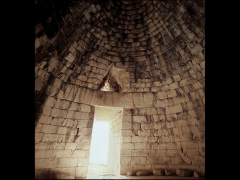
Arch masonry structure. A vault made by projecting courses of stone. Each course of stone projects slightly above the other til they meet |
|
|
Amphora: Time Period:
|

An ancient Greek or Roman jar for storing oil or wine, with an egg-shaped body and two curved handles. |
|
|
Kore: Time Period: |

An Archaic statue of a young woman. Greek and Aegean. |
|
|
Kouros: Time Period:
|
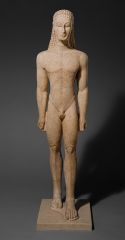
An Archaic statue of a young man or boy. Greek and Aegean. |
|
|
Pediment: Time Period: |
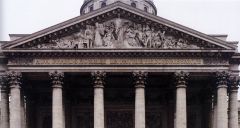
A triangular Gable in classical Greek found over porticos, windows or doors. |
|
|
Peristyle: Time Period: |
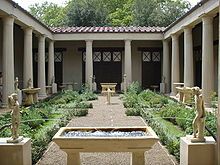
In Greek architecture, a surrounding colonnade. A peristyle building is surrounded on the exterior by a colonnade. A peristyle court is an open colonnaded courtyard, often having a pool or garden. |
|
|
Metope: Time Period:
|
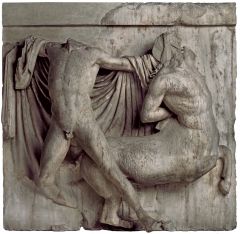
The carved or painted rectangular panel between the triglyphs of a Doric frieze. Aegean and Greek. |
|
|
Triglyph: Time Period: |
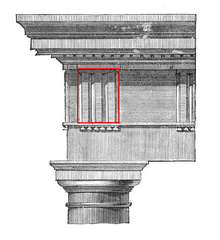
Rectangular block between the metopes of a Doric frieze. Identified by three carved vertical grooves, which approximate the appearance of the end of wooden beams. |
|
|
Cella: Time Period: |
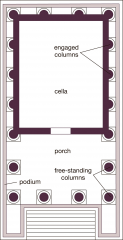
The principle interior room at the center of a Greek or Roman temple within which the cult statue was usually housed. Also called the naos. |
|
|
Entasis: Time Period: |
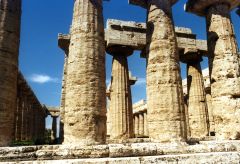
A slight swelling of the shaft of a Greek column. The optical illusion of entasis makes the column appear to be straight from a distance. |
|
|
Order (in architecture: Time Period: |
A system of proportions in Classical architecture that includes every aspect of the building's plan, elevation, and decorative system. |
|
|
Doric: Time Period: |

The column shaft can be fluted or smooth-surfaced and has no base. Consists of an undecorated echinus and abacus. Plain architrave, a frieze with metopes and triglyphs, and a simple cornice. |
|
|
Ionic: Time Period:
|
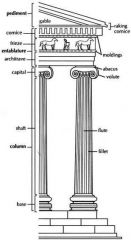
The column of this order has a base, fluted shaft, and a capital decorated with volutes. Entablature consists of an architrave of three panels and moldings, a frieze containing a sculpted relief ornament, and a cornice with dentils. |
|
|
Frieze: Time Period: |
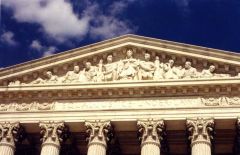
The middle element of an entablature, between the architrave and the cornice. Usually decorated with sculpture, paintings, or moldings. Also, any continuous flat band of relief sculpture or painted decoration. |
|
|
Contrapposto:
|
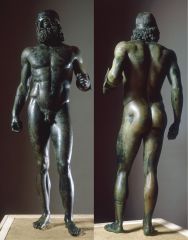
Classical convention or representing human figures with opposing alternations of tension and relaxation. |
|
|
Nike: Time Period: |
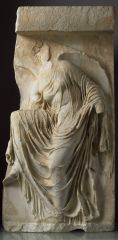
Greek goddess of victory in war. |
|
|
Concrete: Time Period: |
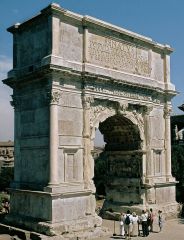
a heavy, rough building material made from a mixture of broken stone or gravel, sand, cement, and water, that can be spread or poured into molds and that forms a stonelike mass on hardening. Arch of Titus from Roman period was made of concrete.
|
|
|
Illusionism: Time Period: |
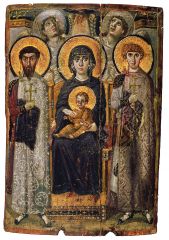
Refers to a highly detailed style of art in Roman/Byzantine time that seeks to create a convincing illusion of physical reality by describing its visual appearance meticulously. Appears to be life-like.
|
|
|
Dome: Time Period: |
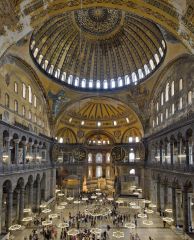
a vault, having a circular plan and usually in the form of a portion of a sphere, so constructed as to exert an equal thrust in all directions. Ex: Hagia Sophia (Roman)
|
|
|
Round (or Roman) arch:
|
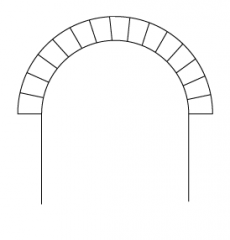
an arch formed in a continuous curve, especially in a semicircle.
|
|
|
Barrel (or tunnel) vault: Time Period: |

Barrel or tunnel vault: an elongated or continuous semicircular vault, shaped like a halfcylinder.
|
|
|
Groin vault: Time Period: |
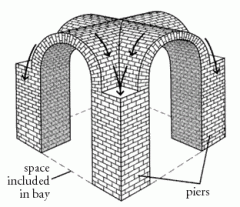
When two barrel-vaults intersect each other, a groin vault is created. |
|
|
Triumphal arch: Time Period: |
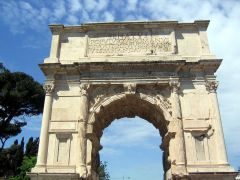
a monumental archway, often erected in permanent materials as a commemorative structure, straddling the line of march of a victorious army during a triumphal procession. |
|
|
Equestrian: Time Period: |
representing a person mounted on a horse. Roman. |
|
|
Rotunda: Time Period: |
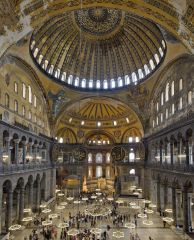
Any building constructed in a circular shape, usually creating an interior dome.
|
|
|
Coffers: Time Period: |
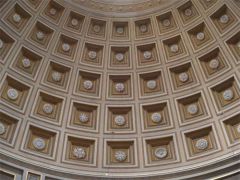
A Recessed decorative panel used to decorate ceilings or vaults.
|
|
|
Oculus: Time Period: |
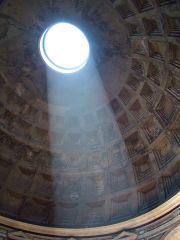
In Roman architecture, a circular opening. Usually found as windows or at the apex of a dome. When at the top of a dome, it is open to the sky. |
|
|
Basilica: Time Period: |

A large, rectangular building. Originally Roman centers for administration, later Christian church use. Has an apse, colonnades, and a nave. |
|
|
Nave: Time Period:
|
The principle room in a temple or a church. In ancient architecture, the cella. In Roman or Byzantine art, the nave and santuary. |
|
|
Apse: Time Period: |
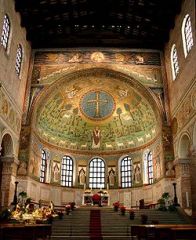
a large semicircular or polygonal recess in a church, arched or with a domed roof, typically at the eastern end, and usually containing the altar. |
|
|
Atmospheric Perspective: Time Period: |

A system for representing a three dimensional space on a two dimensional surface. Like painting a window and a landscape on a flat wall. |
|
|
Intuitive Perspective: Time Period: |
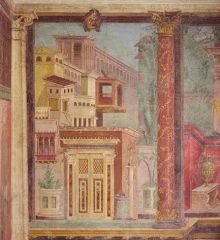
The method of giving a painting the impression of recession just by visual instinct, instead of using an actual program or mathematics. |
|
|
Tetrarchs: Time Period: |
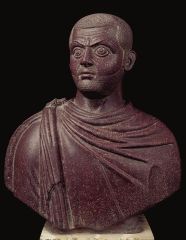
Rulers and leaders depicted ideologically, geometrically abstracted, with no sure likeness. Embody power, harshness, and character of the ruler. |
|
|
Catacomb:
|
An underground cemetery, consisting of tunnels on different levels. Early Christian/Byzantine |
|
|
Pendentive: Time Period: |
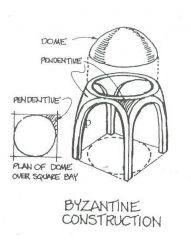
The concave triangular section of a vault that forms the transition between a square space and the circular base of the dome. Early Christian/Byzantine |
|
|
Icon: Time Period: |
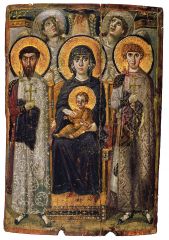
An image representing a sacred figure or event in the Byzantine church. Icons are worshiped, and they are believed to be a link to the Divine. Early Christian/Byzantine |
|
|
Iconoclasm: Time Period: |
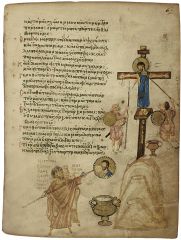
Is the prohibition and destruction of works of visual art, usually because they are inappropriate in religious contexts. Byzantine. Early Christian/Byzantine |
|
|
Baptistry: ( or baptistery) Time Period: |
the part of a church used for baptism. Roman or Byzantine.
|
|
|
Transept: Time Period: |
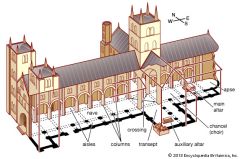
the area of a cruciform church lying at right angles to the principal axis. Early Christian/Byzantine |
|
|
Pier: Time Period: |
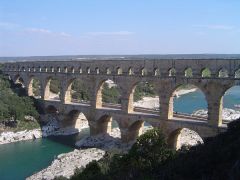
A masonry support made of many stones, or rubble and concrete. Often Square or rectangular. Capable of carrying heavy architectural loads. Early Christian/Byzantine
|

